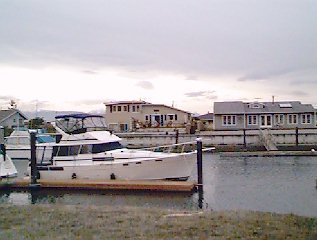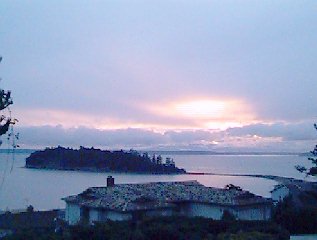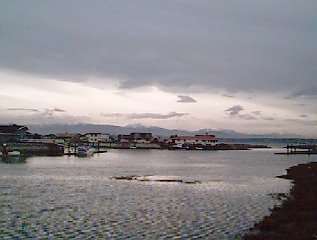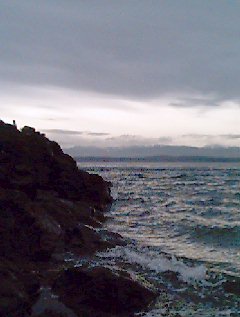

 Low
cost consumer digital cameras finally arrive in a big way with the mail order
street price of Kodak's DC20 Digital Camera dropping to around $200. When
this camera first arrived on the scene I really wasn't overly impressed,
due to a much higher price, its limited features and with the quality of
the images it produces and their resolution less than that of those real
cool $5,000 to $15,000 professional cameras we've been drooling over. At
the current price however this little modern day brownie makes a great addition
to the family computer and is a must have item for anyone who maintains a
web site that doesn't have a thousand bucks or more to spend on a digital
camera. This camera is certainly no high end digital, but it gets the job
done at a cost less than any other manufacturer's entry, producing images
that rival digital cameras selling for over twice the price. Simply put,
the DC20 is a great little camera for your average digital shutter bug.
Low
cost consumer digital cameras finally arrive in a big way with the mail order
street price of Kodak's DC20 Digital Camera dropping to around $200. When
this camera first arrived on the scene I really wasn't overly impressed,
due to a much higher price, its limited features and with the quality of
the images it produces and their resolution less than that of those real
cool $5,000 to $15,000 professional cameras we've been drooling over. At
the current price however this little modern day brownie makes a great addition
to the family computer and is a must have item for anyone who maintains a
web site that doesn't have a thousand bucks or more to spend on a digital
camera. This camera is certainly no high end digital, but it gets the job
done at a cost less than any other manufacturer's entry, producing images
that rival digital cameras selling for over twice the price. Simply put,
the DC20 is a great little camera for your average digital shutter bug.
 The DC20 I received came
packaged with Kai's Power Goo and PhotoEnhancer software, flash attachment,
ink jet printing paper and a serial cable to connect the camera to a computer.
For the purposes of this review I am going to stick to discussing the DC20,
accessories, and the basic Twain image acquisition software installed on
a typical affordable family 386DX computer with four megabytes of ram running
Windows 3.1 and driving a 256 color display monitor without a cd-rom. The
reason for setting up the camera on such a basic system is due to the fact
that I realize many of the people who use my graphical editing software "Image
Magician" have just such a system. If you happen to have a newer computer
system with a few extra bells and whistles you can expect fewer setup problems
and increased performance not to mention be able to use all the great software
which comes with the DC20.
The DC20 I received came
packaged with Kai's Power Goo and PhotoEnhancer software, flash attachment,
ink jet printing paper and a serial cable to connect the camera to a computer.
For the purposes of this review I am going to stick to discussing the DC20,
accessories, and the basic Twain image acquisition software installed on
a typical affordable family 386DX computer with four megabytes of ram running
Windows 3.1 and driving a 256 color display monitor without a cd-rom. The
reason for setting up the camera on such a basic system is due to the fact
that I realize many of the people who use my graphical editing software "Image
Magician" have just such a system. If you happen to have a newer computer
system with a few extra bells and whistles you can expect fewer setup problems
and increased performance not to mention be able to use all the great software
which comes with the DC20.
 To
begin with I would like to mention, and I hope that all manufacturers of
hardware and software are listening, that not everyone has a cd-rom drive
installed on their computer, nor do they necessarily have an internet connection.
The DC20's relatively brief documentation and the basic software necessary
to get you up and running being included only on cd-rom can present a problem
unless you have access to the internet so you can download the Twain driver
from Kodak's web site, which by the way, I would not have known was available
from their web site if I had not toured the site on several occasions in
the past. The Twain driver I downloaded from Kodak was easy to install, simply
a matter of running the self extracting zip file then running the install
program, everything went quickly and smoothly without a hitch. The camera
will need access to your COM-2 port so if you're like myself and have your
modem on that port you will need to reconfigure it to COM-3. Kodak does a
very good job with documenting COM port problems on their web site and no
matter how you have your machine configured you should be able to solve any
problems you run into. You will probably also require a 9-25 pin COM port
serial adapter if your computer is equipped with a 25 pin connector as the
DC20 ships with a 9 pin connector cord.
To
begin with I would like to mention, and I hope that all manufacturers of
hardware and software are listening, that not everyone has a cd-rom drive
installed on their computer, nor do they necessarily have an internet connection.
The DC20's relatively brief documentation and the basic software necessary
to get you up and running being included only on cd-rom can present a problem
unless you have access to the internet so you can download the Twain driver
from Kodak's web site, which by the way, I would not have known was available
from their web site if I had not toured the site on several occasions in
the past. The Twain driver I downloaded from Kodak was easy to install, simply
a matter of running the self extracting zip file then running the install
program, everything went quickly and smoothly without a hitch. The camera
will need access to your COM-2 port so if you're like myself and have your
modem on that port you will need to reconfigure it to COM-3. Kodak does a
very good job with documenting COM port problems on their web site and no
matter how you have your machine configured you should be able to solve any
problems you run into. You will probably also require a 9-25 pin COM port
serial adapter if your computer is equipped with a 25 pin connector as the
DC20 ships with a 9 pin connector cord.
 If you don't have a cd-rom and aren't able to install the software you will
need an image editing application which supports Kodak's Twain driver. My
first choice was Logitech's FotoTouch software which unfortunately after
I selected the DC20 Twain source only provided me with an error message telling
me to contact Logitech. Just happening to have a shareware copy of Paint
Shop Pro, from JASC, around I decided to give it a try and to my unexpected
delight was greeted by the Kodak DC20's image acquisition window, nice and
basic, just a few menu buttons and functions to choose from, real simple,
I like it! Turn the camera on, click the second menu button to acquire camera
images, click on the image you want to load into your editor, click the transfer
image button then edit and save your photo. One nice surprise is that you
are able to leave the DC20 connected and turned on to take pictures live,
there's even a software timer you can set to a 10 second delay allowing you
to click on the take picture button then stand back and get in the shot yourself.
It took a little effort and some experimentation to find a practical use
for the DC20's timer however I found that I was able to generate an animation
sequence quite easily with the assistance of Windows macro recorder. Once
the animation frames were completed GIF Construction Set's Animation Wizard,
from Alchemy MindWorks, was used to generate an animated GIF movie. It really
would be nice if the serial cord provided by Kodak to connect the camera
and computer were longer to allow for more flexibility in camera placement,
but then for the price of the DC20 can we complain?
If you don't have a cd-rom and aren't able to install the software you will
need an image editing application which supports Kodak's Twain driver. My
first choice was Logitech's FotoTouch software which unfortunately after
I selected the DC20 Twain source only provided me with an error message telling
me to contact Logitech. Just happening to have a shareware copy of Paint
Shop Pro, from JASC, around I decided to give it a try and to my unexpected
delight was greeted by the Kodak DC20's image acquisition window, nice and
basic, just a few menu buttons and functions to choose from, real simple,
I like it! Turn the camera on, click the second menu button to acquire camera
images, click on the image you want to load into your editor, click the transfer
image button then edit and save your photo. One nice surprise is that you
are able to leave the DC20 connected and turned on to take pictures live,
there's even a software timer you can set to a 10 second delay allowing you
to click on the take picture button then stand back and get in the shot yourself.
It took a little effort and some experimentation to find a practical use
for the DC20's timer however I found that I was able to generate an animation
sequence quite easily with the assistance of Windows macro recorder. Once
the animation frames were completed GIF Construction Set's Animation Wizard,
from Alchemy MindWorks, was used to generate an animated GIF movie. It really
would be nice if the serial cord provided by Kodak to connect the camera
and computer were longer to allow for more flexibility in camera placement,
but then for the price of the DC20 can we complain?
 The DC20 is ready to start
shooting with as soon as you pop the single 3 volt lithium battery in its
compartment and depress the power on button. You only have three control
buttons on the DC20, power, erase and of course a shutter button, the detachable
flash accessory has its own power button. The DC20 allows you to setup the
camera via Kodak's Twain software prior to use letting you choose between
8 high resolution (493 x 373 pixels) or 16 low resolution (320 x 240 pixels)
pictures. You can also reset the automatic power off from Kodak's default
value of 90 seconds to as long as 5 minutes thus allowing you ample time
to setup your shot before the unit turns itself off. The camera is equipped
with an erase button, but it erases all images in memory when pressed, there
is no provision for either viewing your images when not connected with a
computer or selectively erasing them, it's a matter of all or nothing.
The DC20 is ready to start
shooting with as soon as you pop the single 3 volt lithium battery in its
compartment and depress the power on button. You only have three control
buttons on the DC20, power, erase and of course a shutter button, the detachable
flash accessory has its own power button. The DC20 allows you to setup the
camera via Kodak's Twain software prior to use letting you choose between
8 high resolution (493 x 373 pixels) or 16 low resolution (320 x 240 pixels)
pictures. You can also reset the automatic power off from Kodak's default
value of 90 seconds to as long as 5 minutes thus allowing you ample time
to setup your shot before the unit turns itself off. The camera is equipped
with an erase button, but it erases all images in memory when pressed, there
is no provision for either viewing your images when not connected with a
computer or selectively erasing them, it's a matter of all or nothing.
 Once we have Familiarized ourselves with the DC20 and taken care of the basic
hardware and software installation we're ready to take the camera for a test
drive. Kodak says any subject within 20 inches to infinity is fair game although
my interest in macro photography prompted me to push it to as close as 8
inches with results which I considered to be just as good as at 20 inches
or more. You'll have to experiment a bit with framing extreme closeups though
due to the range finder having no parallax marking to assist you. Other than
possessing an ability to focus in on a subject as close as 8 inches for a
little bit of macro work the DC20 has most of the idiosyncrasies of your
everyday inexpensive film camera such as avoiding taking pictures directly
in the direction of the sun. The shutter speed is high enough (1/4000 sec
- f11) in bright light and flash to freeze an action shot while the camera's
high light sensitivity (eq. ISO 800-1600) and lower shutter speeds (1/30
sec - f4) allow you to shoot indoors without the flash attachment providing
the room is fairly well lighted.
Once we have Familiarized ourselves with the DC20 and taken care of the basic
hardware and software installation we're ready to take the camera for a test
drive. Kodak says any subject within 20 inches to infinity is fair game although
my interest in macro photography prompted me to push it to as close as 8
inches with results which I considered to be just as good as at 20 inches
or more. You'll have to experiment a bit with framing extreme closeups though
due to the range finder having no parallax marking to assist you. Other than
possessing an ability to focus in on a subject as close as 8 inches for a
little bit of macro work the DC20 has most of the idiosyncrasies of your
everyday inexpensive film camera such as avoiding taking pictures directly
in the direction of the sun. The shutter speed is high enough (1/4000 sec
- f11) in bright light and flash to freeze an action shot while the camera's
high light sensitivity (eq. ISO 800-1600) and lower shutter speeds (1/30
sec - f4) allow you to shoot indoors without the flash attachment providing
the room is fairly well lighted.

 The
DC20 is a very basic digital camera lacking several of the features found
on Kodak's more expensive digital cameras such as the DC50, just keep in
mind that at the $200.00 the DC20 is going for you can forgive one whole
heck of a lot. My biggest DC20 gripe is that of image quality and resolution,
although this little camera will produce what I would consider the best image
quality and resolution of any manufacture's low end digital camera I have
used it still falls short of being able to capture those shots you really
want to keep in your album for generations to come. For many such as myself
who believe film will remain the most accurate means of professional image
capture these limitations should not present a problem, if it's quality we
want we'll still capture it on film then scan it anyway, no digital camera
is capable of the kind of quality and resolution that film can offer or the
scanned images that can be produced from such photographs. What the DC20
can provide us with are quick, small, inexpensive and fairly good quality
digital images perfect for the digital image hobbyist or web site developer
on a tight budget. I found the quality of the images improved dramatically
when they were reduced in size, high resolution 493 x 373 images reduced
to 320 x 240, and the low resolution 320 x 240 images reduced to 160 x 120.
If size takes precedence over quality then I would suggest using your image
editor's sharpening function. You also need to be certain to remember to
use the Twain software to apply white balance correction before transferring
the image as it will make a huge difference in image quality. One of the
best features with this and any digital camera is that your time and maybe
a battery or two is all it's going to cost to experiment with no film or
processing to pay for, you do it all yourself with software on your computer,
it just doesn't get any cheaper than this to take pictures, thanks
Kodak.
The
DC20 is a very basic digital camera lacking several of the features found
on Kodak's more expensive digital cameras such as the DC50, just keep in
mind that at the $200.00 the DC20 is going for you can forgive one whole
heck of a lot. My biggest DC20 gripe is that of image quality and resolution,
although this little camera will produce what I would consider the best image
quality and resolution of any manufacture's low end digital camera I have
used it still falls short of being able to capture those shots you really
want to keep in your album for generations to come. For many such as myself
who believe film will remain the most accurate means of professional image
capture these limitations should not present a problem, if it's quality we
want we'll still capture it on film then scan it anyway, no digital camera
is capable of the kind of quality and resolution that film can offer or the
scanned images that can be produced from such photographs. What the DC20
can provide us with are quick, small, inexpensive and fairly good quality
digital images perfect for the digital image hobbyist or web site developer
on a tight budget. I found the quality of the images improved dramatically
when they were reduced in size, high resolution 493 x 373 images reduced
to 320 x 240, and the low resolution 320 x 240 images reduced to 160 x 120.
If size takes precedence over quality then I would suggest using your image
editor's sharpening function. You also need to be certain to remember to
use the Twain software to apply white balance correction before transferring
the image as it will make a huge difference in image quality. One of the
best features with this and any digital camera is that your time and maybe
a battery or two is all it's going to cost to experiment with no film or
processing to pay for, you do it all yourself with software on your computer,
it just doesn't get any cheaper than this to take pictures, thanks
Kodak.

Related Links
Kodak's Home
Page
Click here drmagnell@aol.comto E-Mail
me
Return to Dr. John's Home Page
Image Magician...
Image Editing & Photo Retouching
Software
Dr. John's Photo Scanning
Service